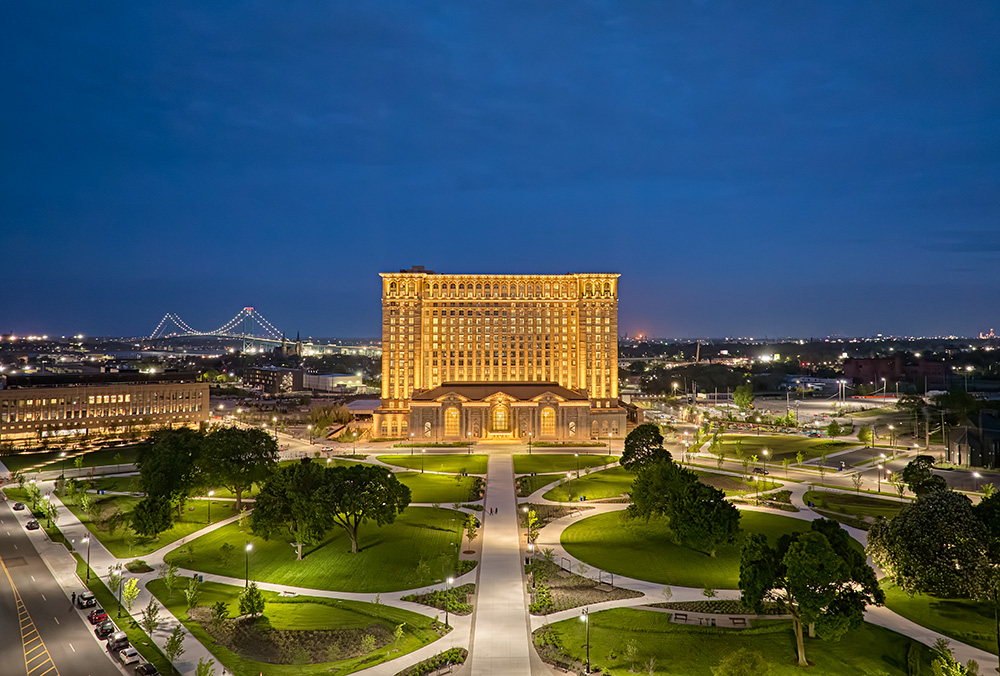The motto of the city of Detroit is:Speramus Meliora; Revive Cineribuswhich in Latin means, “We hope for better things; it will rise from the ashes.” Sulpician Father Gabriel Richard, often called the second founder of Detroit, wrote these words as he surveyed the ruins of the city after the Great Fire of 1805.
There are no words that better describe the recent reopening and transformation of Michigan Central Station in the Corktown neighborhood.
The station was built in 1912 and opened on December 26, 1913, after the previous station burned down. It was designed by the architects who built Grand Central Station in New York City. It was a marvel for its time: a three-story depot with 10 platforms, an 18-story tower, more than 500 offices, a restaurant, a barber shop, a flower shop, bathing facilities, and much more. The station connected Detroit to cities across the country.
With the rise of American suburbs and the advent of automobiles in the 1950s, rail service began to decline. The last train left the station in January 1988. It stood empty for decades, becoming a painful symbol of the city as the building fell into disrepair and was subject to vandalism.
Decades after its closure, the dilapidated building embodied what people said or thought about Detroit, Michigan: This city is dead. There is no life or rebirth here. It is a wasteland. After the race riots in the 1960s, people left the city and moved to the suburbs. All we have is high crime rates and poverty.
There have been several attempts over the years to make plans to save and use this historic building, but they all failed. In 2018, Ford Motor Company purchased the building with plans to completely transform it for the benefit of the neighborhood and the city.
Bill Ford, chairman of Ford’s board of directors, put it best: “This station was our Ellis Island – a place where dreamers first entered Detroit in search of new jobs and new opportunities. But when the last train left, it became a place where hope faded.”
The historicity of this place means a lot to locals because it represented something in its time. Michigan Central Station was the arrival point for thousands of immigrants who came to work in the automobile plants in search of a new life and better opportunities.
This is where blacks came to escape Jim Crow laws in the South. This is where immigrants came, eager to find work. This neighborhood became home to many Hispanics and Irish, communities that have strong roots in the neighborhoods. The hopes, dreams, prayers and stories of so many people passed through this station.
The Corktown neighborhood has been my home for the past nine months, and a few weeks before I moved for a new job, I had the opportunity to visit the newly renovated building a few times.
The new building was breathtaking – in some ways it felt like entering a beautiful old cathedral in Europe. It left me speechless. You could almost feel the sacredness of the space, as if the energy of all the dreams and stories of those who passed through the station had somehow been collected and could still be felt to this day. It was a sacred moment.
On my second visit, I wanted to enjoy the beauty of the place. I sat in the Great Hall for almost 45 minutes. I looked at all the beauty around me. I saw people of all ages walking around and taking in the place, reading the posters telling the history of the station, and some even shed tears.
I heard this still, small voice in my heart: “Enjoy this, Patty. Enjoy this.”
Enjoying this beauty, these stories, the peaceful music, the other people around me who were equally moved when they came in.
Sometimes we forget the spiritual realities that surround us. Buildings and places can be opportunities and invitations to encounter God. The experience of taking in a beautiful building like Michigan Central Station can be as moving as a summer sunset, a meaningful worship service, or a walk in the quiet of the forest.
God meets us in all kinds of places. The divine presence is not tied to a specific method of finding and connecting with you and me.
When Michigan Central Station opened, it was a central hub for rail transit. Now, in this new era, it embodies the words of the city’s motto, a true “rise from the ashes” in more ways than one.
Today, Michigan Central becomes a place of innovation, a beacon of new development, and an opportunity to lead this local community and the city of Detroit further into the future. It is a call to hope, recognizing that we are not defined by struggles or challenges, but can rise from the ashes with hope as the fuel for better things.

